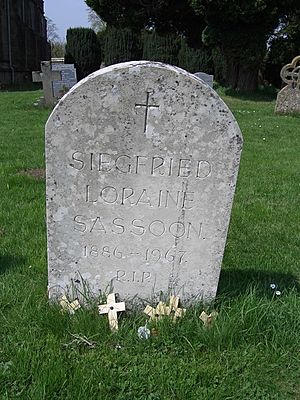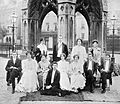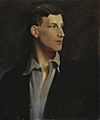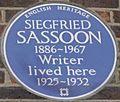Siegfried Sassoon facts for kids
Quick facts for kids
Siegfried Sassoon
|
|
|---|---|
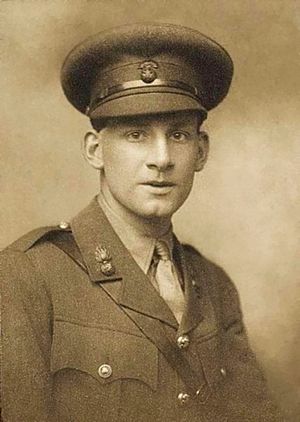
Siegfried Sassoon in 1915
|
|
| Born | 8 September 1886 |
| Died | 1 September 1967 (aged 80) Heytesbury, Wiltshire, England
|
| Nationality | English |
| Known for | Poet and novelist |
Siegfried Sassoon was an English poet and writer. He lived from 1886 to 1967. He became famous for speaking out against the First World War in 1917.
Contents
Early Life and Family
Siegfried Sassoon's father, Alfred, came from a very rich family. However, his family did not approve of his marriage. Because of this, he did not receive any family money. Siegfried's mother, Theresa, came from a family of artists.
Alfred and Theresa had three sons: Michael, Siegfried, and Hamo. Siegfried's father left the family when Siegfried was young. Alfred died soon after, and Siegfried's mother, Theresa, raised the three boys. They lived comfortably in a large house in Kent, England.
Becoming a Soldier and Poet
As a young man, Siegfried loved horses. He was a very good rider. His biggest dream was to become a famous poet. He did not find a publisher for his poems until just before the First World War began.
When the war started, he joined the army. He chose a group called the Sussex Yeomanry. He did this so his horse could go with him. After a riding accident, he joined an infantry (foot soldier) group. He became an officer in the Royal Welch Fusiliers.
Sassoon was sent to France to fight on the Western Front. He was shocked by the terrible things he saw. He became friends with another poet, Robert Graves. Graves suggested that Sassoon write more realistically about his war experiences. Sassoon took his advice and changed his poetry style.
Protesting the War
By 1917, many of Sassoon's friends and his brother had been killed. He became very angry about the war. He had been given the Military Cross for his bravery. But he did not see it as a great honor.
When he was sent home to recover from a wound, he met people who were against the war. He began to believe that politicians were making the war last too long. He thought they were missing chances to make peace.
Sassoon decided not to go back to his army group. He felt very sad. He tore the ribbon from his medal and threw it in a river. Then, he wrote a letter to his commanding officer. He explained that he would not return because he wanted to protest the war.
Normally, soldiers who did this would face a court-martial (a military trial). But because of Sassoon's good record, he was given another chance. His friend Robert Graves told officers that Sassoon was very depressed. He said Sassoon was too ill to fight.
Sassoon was sent to a hospital in Edinburgh. This hospital helped officers with mental health issues. Sassoon did not like being there. He felt he was not truly ill. His doctor, W. H. R. Rivers, greatly influenced him. Rivers became like a father figure to him.
While at the hospital, Sassoon met another young officer, Wilfred Owen. Owen admired Sassoon's poetry. They became close friends. Sassoon helped Owen write better poems. We know this because one of Owen's famous poems, Anthem for Doomed Youth, shows corrections in Sassoon's handwriting.
Sassoon and Owen were separated after a few months. Sassoon finished his time at the hospital. He agreed to go back to his army group.
Returning to the Front and Later Life
Sassoon was not sent back to France right away. He fought for a few months in Palestine. The troops there were in less danger. After that, he returned to France. But he was wounded again soon after. This wound was serious enough to stop him from fighting again.
He stayed in touch with Wilfred Owen. Owen had also left the hospital. He was sent back to his group in France. Sadly, Owen was killed a few days before the war ended.
Sassoon's poetry became very popular during the war. After the war, he went through a period of sadness. His friend Rivers died suddenly. Sassoon felt he had nothing left to write about.
He later wrote about his life in novels. His first book was Memoirs of a Fox-Hunting Man (1928). He published it without his name at first. He was known as a poet and was unsure about writing stories. He called the main character "George Sherston," but it was based on himself. The book was a huge success. Sassoon wrote two more books continuing the story. He later wrote three more books about his life, this time using real names. These books were also very popular.
Later Years and Legacy
At age 47, Sassoon married Hester. She was much younger than him. Sassoon really wanted to be a father. They moved into a large house in Wiltshire. He had bought it with money he received from his aunt.
Two years after they married, Hester had their son, George (1936-2006). Hester did not want more children. This caused many arguments between them. After the Second World War, they agreed to divorce. Hester moved to Scotland with George. Siegfried still saw his son. But he wished they could have had a closer relationship.
Sassoon remained a respected writer until he died. He had many friends in the world of literature. This included another poet, Edmund Blunden. In 1951, he received the CBE. In 1957, he was awarded the Queen's Gold Medal for Poetry.
Sassoon was raised in the Church of England by his mother. His war experiences made him question his faith. He was not very religious until later in his life. In 1957, after much thought, he became a Roman Catholic. He remained Catholic until his death at age eighty. He was buried in the churchyard at Mells in Somerset.
Images for kids
-
Sassoon (front) with his brother Hamo and other students at Cambridge University in 1906.
-
Portrait of Sassoon by Glyn Warren Philpot, 1917 (Fitzwilliam Museum).
-
An agreement from Arthur Quiller-Couch for Sassoon to write for The Daily Herald.
-
Blue plaque, 23 Campden Hill Square, London.
-
Poem Everyone Sang by Sassoon on a wall in The Hague.
-
Green plaque on the site of Sassoon's former home in Tufton Street, Westminster, London.
See also
 In Spanish: Siegfried Sassoon para niños
In Spanish: Siegfried Sassoon para niños


